belt LINCOLN MKT 2018 Owner's Manual
[x] Cancel search | Manufacturer: LINCOLN, Model Year: 2018, Model line: MKT, Model: LINCOLN MKT 2018Pages: 564, PDF Size: 4.66 MB
Page 42 of 564
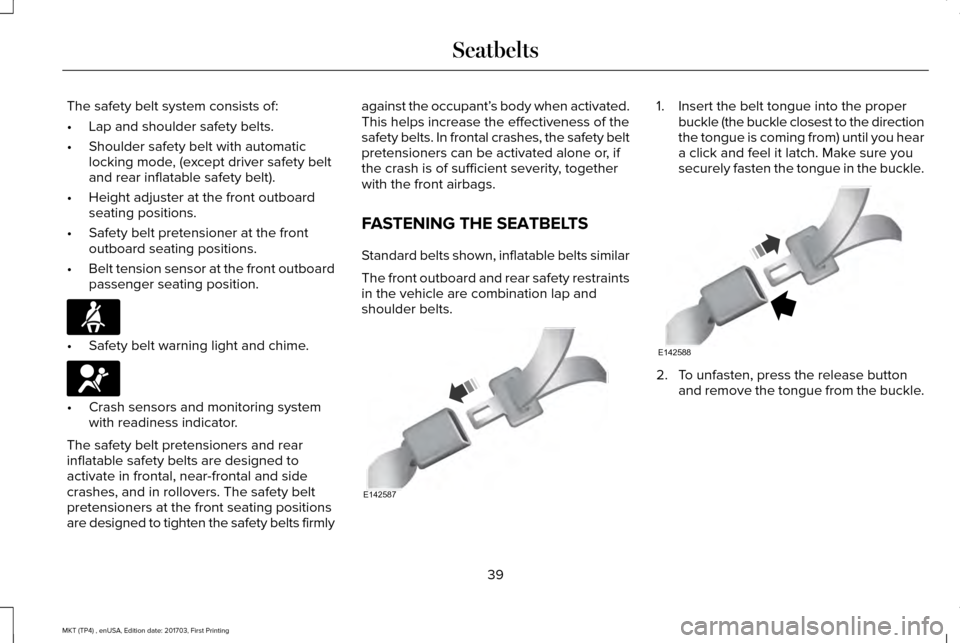
The safety belt system consists of:
•
Lap and shoulder safety belts.
• Shoulder safety belt with automatic
locking mode, (except driver safety belt
and rear inflatable safety belt).
• Height adjuster at the front outboard
seating positions.
• Safety belt pretensioner at the front
outboard seating positions.
• Belt tension sensor at the front outboard
passenger seating position. •
Safety belt warning light and chime. •
Crash sensors and monitoring system
with readiness indicator.
The safety belt pretensioners and rear
inflatable safety belts are designed to
activate in frontal, near-frontal and side
crashes, and in rollovers. The safety belt
pretensioners at the front seating positions
are designed to tighten the safety belts firmly against the occupant’
s body when activated.
This helps increase the effectiveness of the
safety belts. In frontal crashes, the safety belt
pretensioners can be activated alone or, if
the crash is of sufficient severity, together
with the front airbags.
FASTENING THE SEATBELTS
Standard belts shown, inflatable belts similar
The front outboard and rear safety restraints
in the vehicle are combination lap and
shoulder belts. 1. Insert the belt tongue into the proper
buckle (the buckle closest to the direction
the tongue is coming from) until you hear
a click and feel it latch. Make sure you
securely fasten the tongue in the buckle. 2. To unfasten, press the release button
and remove the tongue from the buckle.
39
MKT (TP4) , enUSA, Edition date: 201703, First Printing SeatbeltsE71880 E67017 E142587 E142588
Page 43 of 564
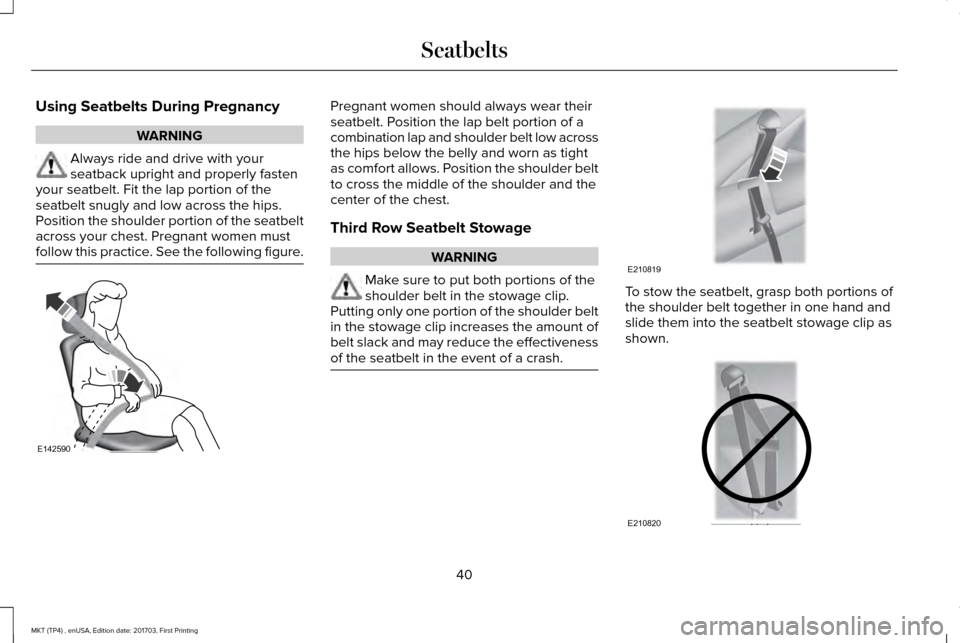
Using Seatbelts During Pregnancy
WARNING
Always ride and drive with your
seatback upright and properly fasten
your seatbelt. Fit the lap portion of the
seatbelt snugly and low across the hips.
Position the shoulder portion of the seatbelt
across your chest. Pregnant women must
follow this practice. See the following figure. Pregnant women should always wear their
seatbelt. Position the lap belt portion of a
combination lap and shoulder belt low across
the hips below the belly and worn as tight
as comfort allows. Position the shoulder belt
to cross the middle of the shoulder and the
center of the chest.
Third Row Seatbelt Stowage
WARNING
Make sure to put both portions of the
shoulder belt in the stowage clip.
Putting only one portion of the shoulder belt
in the stowage clip increases the amount of
belt slack and may reduce the effectiveness
of the seatbelt in the event of a crash. To stow the seatbelt, grasp both portions of
the shoulder belt together in one hand and
slide them into the seatbelt stowage clip as
shown.
40
MKT (TP4) , enUSA, Edition date: 201703, First Printing SeatbeltsE142590 E210819 E210820
Page 44 of 564
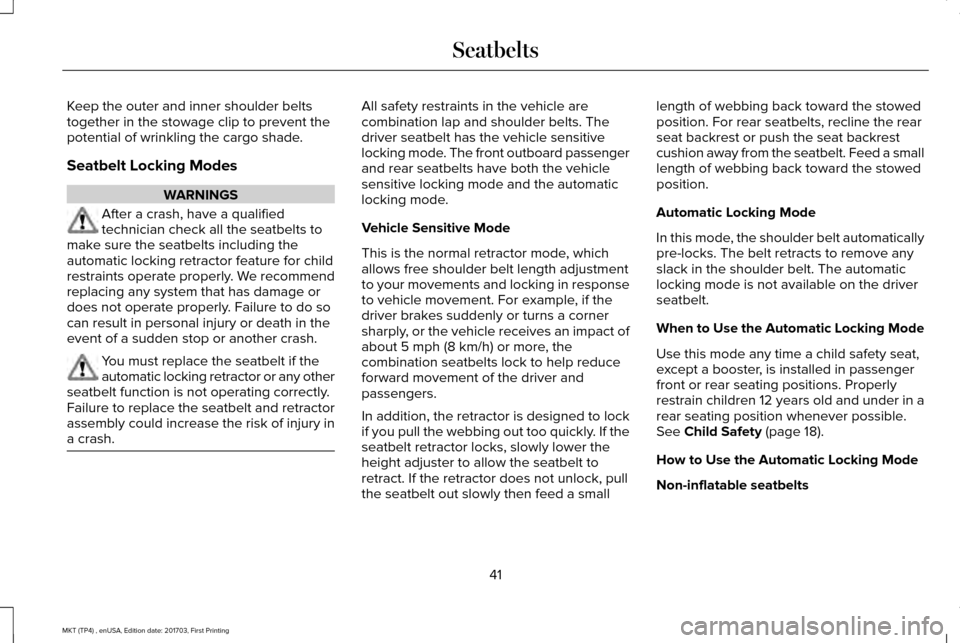
Keep the outer and inner shoulder belts
together in the stowage clip to prevent the
potential of wrinkling the cargo shade.
Seatbelt Locking Modes
WARNINGS
After a crash, have a qualified
technician check all the seatbelts to
make sure the seatbelts including the
automatic locking retractor feature for child
restraints operate properly. We recommend
replacing any system that has damage or
does not operate properly. Failure to do so
can result in personal injury or death in the
event of a sudden stop or another crash. You must replace the seatbelt if the
automatic locking retractor or any other
seatbelt function is not operating correctly.
Failure to replace the seatbelt and retractor
assembly could increase the risk of injury in
a crash. All safety restraints in the vehicle are
combination lap and shoulder belts. The
driver seatbelt has the vehicle sensitive
locking mode. The front outboard passenger
and rear seatbelts have both the vehicle
sensitive locking mode and the automatic
locking mode.
Vehicle Sensitive Mode
This is the normal retractor mode, which
allows free shoulder belt length adjustment
to your movements and locking in response
to vehicle movement. For example, if the
driver brakes suddenly or turns a corner
sharply, or the vehicle receives an impact of
about 5 mph (8 km/h) or more, the
combination seatbelts lock to help reduce
forward movement of the driver and
passengers.
In addition, the retractor is designed to lock
if you pull the webbing out too quickly. If the
seatbelt retractor locks, slowly lower the
height adjuster to allow the seatbelt to
retract. If the retractor does not unlock, pull
the seatbelt out slowly then feed a small length of webbing back toward the stowed
position. For rear seatbelts, recline the rear
seat backrest or push the seat backrest
cushion away from the seatbelt. Feed a small
length of webbing back toward the stowed
position.
Automatic Locking Mode
In this mode, the shoulder belt automatically
pre-locks. The belt retracts to remove any
slack in the shoulder belt. The automatic
locking mode is not available on the driver
seatbelt.
When to Use the Automatic Locking Mode
Use this mode any time a child safety seat,
except a booster, is installed in passenger
front or rear seating positions. Properly
restrain children 12 years old and under in a
rear seating position whenever possible.
See
Child Safety (page 18).
How to Use the Automatic Locking Mode
Non-inflatable seatbelts
41
MKT (TP4) , enUSA, Edition date: 201703, First Printing Seatbelts
Page 45 of 564
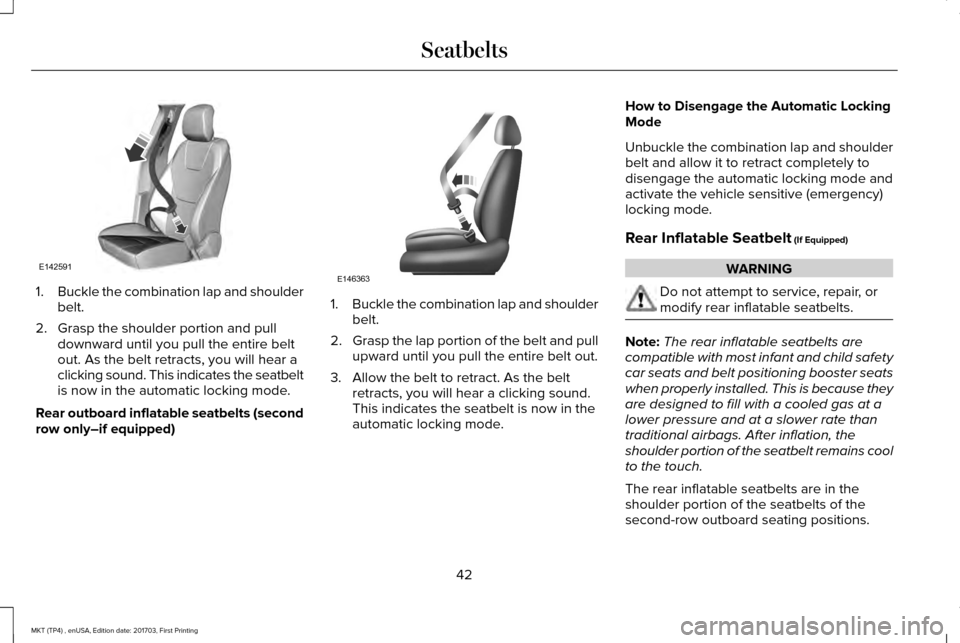
1.
Buckle the combination lap and shoulder
belt.
2. Grasp the shoulder portion and pull downward until you pull the entire belt
out. As the belt retracts, you will hear a
clicking sound. This indicates the seatbelt
is now in the automatic locking mode.
Rear outboard inflatable seatbelts (second
row only–if equipped) 1.
Buckle the combination lap and shoulder
belt.
2. Grasp the lap portion of the belt and pull
upward until you pull the entire belt out.
3. Allow the belt to retract. As the belt retracts, you will hear a clicking sound.
This indicates the seatbelt is now in the
automatic locking mode. How to Disengage the Automatic Locking
Mode
Unbuckle the combination lap and shoulder
belt and allow it to retract completely to
disengage the automatic locking mode and
activate the vehicle sensitive (emergency)
locking mode.
Rear Inflatable Seatbelt (If Equipped) WARNING
Do not attempt to service, repair, or
modify rear inflatable seatbelts.
Note:
The rear inflatable seatbelts are
compatible with most infant and child safety
car seats and belt positioning booster seats
when properly installed. This is because they
are designed to fill with a cooled gas at a
lower pressure and at a slower rate than
traditional airbags. After inflation, the
shoulder portion of the seatbelt remains cool
to the touch.
The rear inflatable seatbelts are in the
shoulder portion of the seatbelts of the
second-row outboard seating positions.
42
MKT (TP4) , enUSA, Edition date: 201703, First Printing SeatbeltsE142591 E146363
Page 46 of 564
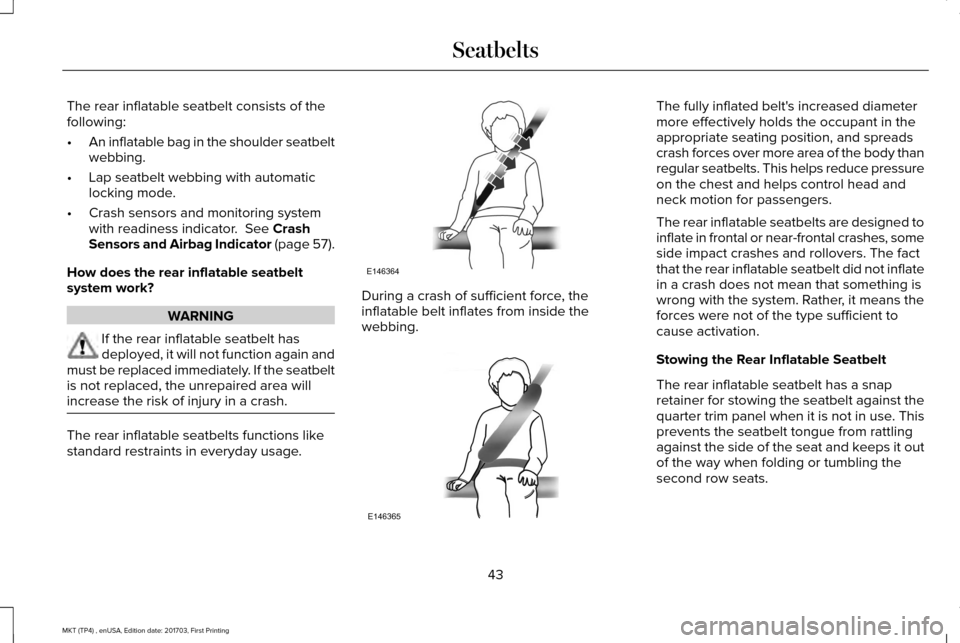
The rear inflatable seatbelt consists of the
following:
•
An inflatable bag in the shoulder seatbelt
webbing.
• Lap seatbelt webbing with automatic
locking mode.
• Crash sensors and monitoring system
with readiness indicator. See Crash
Sensors and Airbag Indicator (page 57).
How does the rear inflatable seatbelt
system work? WARNING
If the rear inflatable seatbelt has
deployed, it will not function again and
must be replaced immediately. If the seatbelt
is not replaced, the unrepaired area will
increase the risk of injury in a crash. The rear inflatable seatbelts functions like
standard restraints in everyday usage. During a crash of sufficient force, the
inflatable belt inflates from inside the
webbing. The fully inflated belt's increased diameter
more effectively holds the occupant in the
appropriate seating position, and spreads
crash forces over more area of the body than
regular seatbelts. This helps reduce pressure
on the chest and helps control head and
neck motion for passengers.
The rear inflatable seatbelts are designed to
inflate in frontal or near-frontal crashes, some
side impact crashes and rollovers. The fact
that the rear inflatable seatbelt did not inflate
in a crash does not mean that something is
wrong with the system. Rather, it means the
forces were not of the type sufficient to
cause activation.
Stowing the Rear Inflatable Seatbelt
The rear inflatable seatbelt has a snap
retainer for stowing the seatbelt against the
quarter trim panel when it is not in use. This
prevents the seatbelt tongue from rattling
against the side of the seat and keeps it out
of the way when folding or tumbling the
second row seats.
43
MKT (TP4) , enUSA, Edition date: 201703, First Printing SeatbeltsE146364 E146365
Page 47 of 564
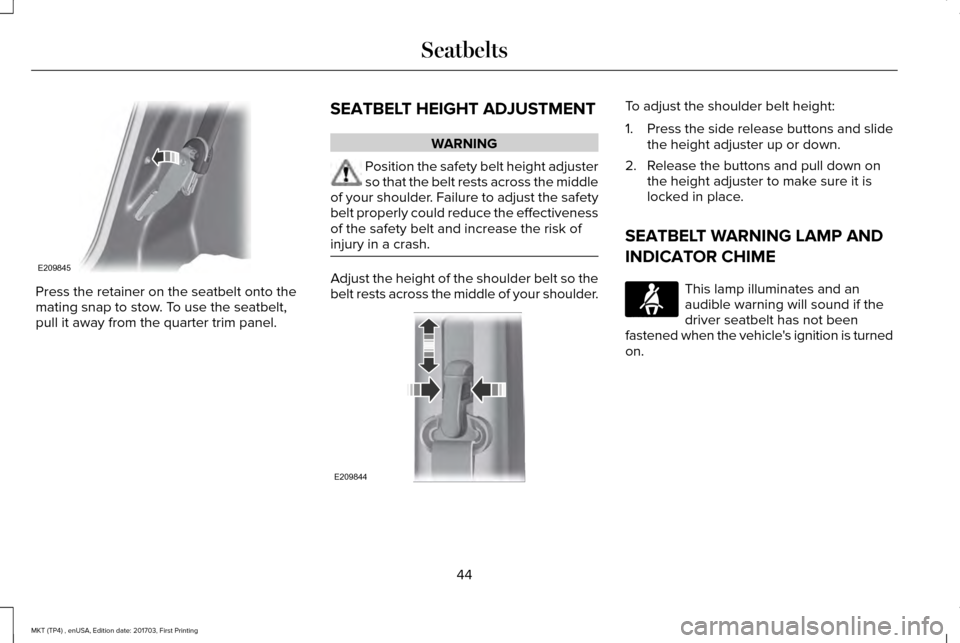
Press the retainer on the seatbelt onto the
mating snap to stow. To use the seatbelt,
pull it away from the quarter trim panel.
SEATBELT HEIGHT ADJUSTMENT WARNING
Position the safety belt height adjuster
so that the belt rests across the middle
of your shoulder. Failure to adjust the safety
belt properly could reduce the effectiveness
of the safety belt and increase the risk of
injury in a crash. Adjust the height of the shoulder belt so the
belt rests across the middle of your shoulder. To adjust the shoulder belt height:
1.
Press the side release buttons and slide
the height adjuster up or down.
2. Release the buttons and pull down on the height adjuster to make sure it is
locked in place.
SEATBELT WARNING LAMP AND
INDICATOR CHIME This lamp illuminates and an
audible warning will sound if the
driver seatbelt has not been
fastened when the vehicle's ignition is turned
on.
44
MKT (TP4) , enUSA, Edition date: 201703, First Printing SeatbeltsE209845 E209844 E71880
Page 48 of 564
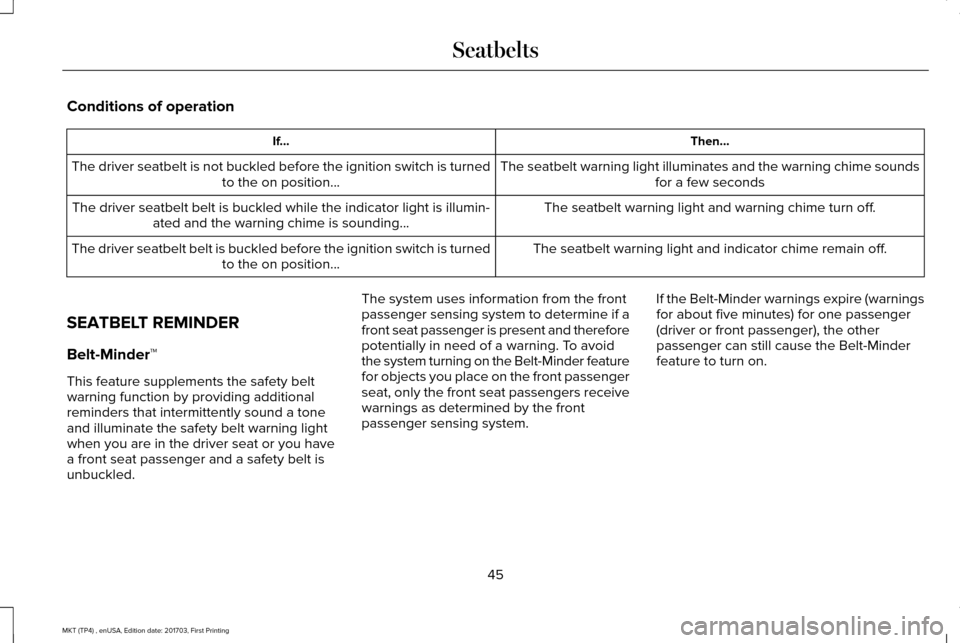
Conditions of operation
Then...
If...
The seatbelt warning light illuminates and the warning chime soundsfor a few seconds
The driver seatbelt is not buckled before the ignition switch is turned
to the on position...
The seatbelt warning light and warning chime turn off.
The driver seatbelt belt is buckled while the indicator light is illumin\
-
ated and the warning chime is sounding...
The seatbelt warning light and indicator chime remain off.
The driver seatbelt belt is buckled before the ignition switch is turned\
to the on position...
SEATBELT REMINDER
Belt-Minder™
This feature supplements the safety belt
warning function by providing additional
reminders that intermittently sound a tone
and illuminate the safety belt warning light
when you are in the driver seat or you have
a front seat passenger and a safety belt is
unbuckled. The system uses information from the front
passenger sensing system to determine if a
front seat passenger is present and therefore
potentially in need of a warning. To avoid
the system turning on the Belt-Minder feature
for objects you place on the front passenger
seat, only the front seat passengers receive
warnings as determined by the front
passenger sensing system.
If the Belt-Minder warnings expire (warnings
for about five minutes) for one passenger
(driver or front passenger), the other
passenger can still cause the Belt-Minder
feature to turn on.
45
MKT (TP4) , enUSA, Edition date: 201703, First Printing Seatbelts
Page 49 of 564
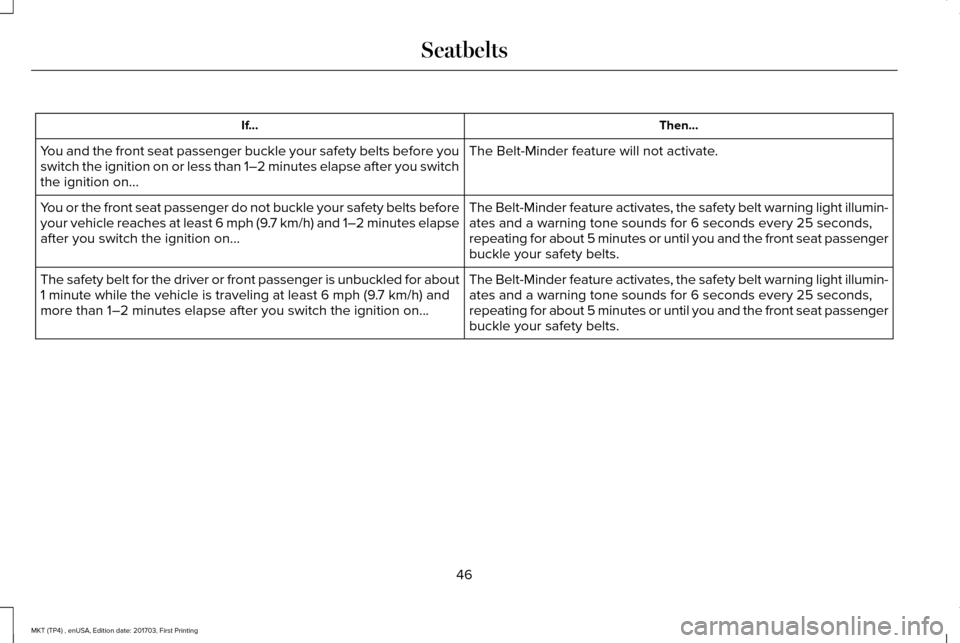
Then...
If...
The Belt-Minder feature will not activate.
You and the front seat passenger buckle your safety belts before you
switch the ignition on or less than 1–2 minutes elapse after you switch
the ignition on...
The Belt-Minder feature activates, the safety belt warning light illumin\
-
ates and a warning tone sounds for 6 seconds every 25 seconds,
repeating for about 5 minutes or until you and the front seat passenger
buckle your safety belts.
You or the front seat passenger do not buckle your safety belts before
your vehicle reaches at least 6 mph (9.7 km/h) and 1–2 minutes elapse
after you switch the ignition on...
The Belt-Minder feature activates, the safety belt warning light illumin\
-
ates and a warning tone sounds for 6 seconds every 25 seconds,
repeating for about 5 minutes or until you and the front seat passenger
buckle your safety belts.
The safety belt for the driver or front passenger is unbuckled for about\
1 minute while the vehicle is traveling at least 6 mph (9.7 km/h) and
more than 1–2 minutes elapse after you switch the ignition on...
46
MKT (TP4) , enUSA, Edition date: 201703, First Printing Seatbelts
Page 50 of 564
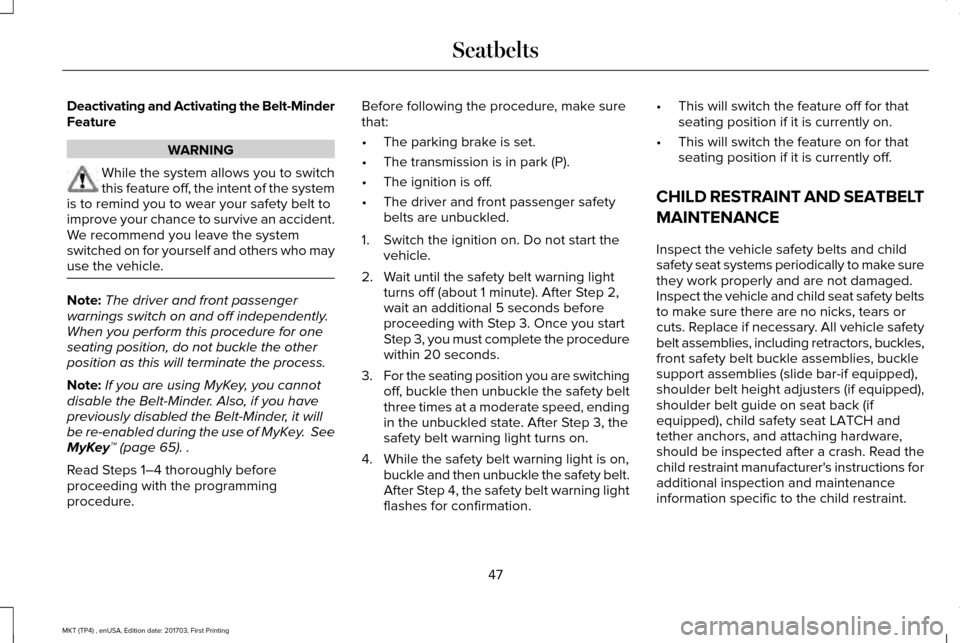
Deactivating and Activating the Belt-Minder
Feature
WARNING
While the system allows you to switch
this feature off, the intent of the system
is to remind you to wear your safety belt to
improve your chance to survive an accident.
We recommend you leave the system
switched on for yourself and others who may
use the vehicle. Note:
The driver and front passenger
warnings switch on and off independently.
When you perform this procedure for one
seating position, do not buckle the other
position as this will terminate the process.
Note: If you are using MyKey, you cannot
disable the Belt-Minder. Also, if you have
previously disabled the Belt-Minder, it will
be re-enabled during the use of MyKey. See
MyKey™ (page 65). .
Read Steps 1–4 thoroughly before
proceeding with the programming
procedure. Before following the procedure, make sure
that:
•
The parking brake is set.
• The transmission is in park (P).
• The ignition is off.
• The driver and front passenger safety
belts are unbuckled.
1. Switch the ignition on. Do not start the vehicle.
2. Wait until the safety belt warning light turns off (about 1 minute). After Step 2,
wait an additional 5 seconds before
proceeding with Step 3. Once you start
Step 3, you must complete the procedure
within 20 seconds.
3. For the seating position you are switching
off, buckle then unbuckle the safety belt
three times at a moderate speed, ending
in the unbuckled state. After Step 3, the
safety belt warning light turns on.
4. While the safety belt warning light is on, buckle and then unbuckle the safety belt.
After Step 4, the safety belt warning light
flashes for confirmation. •
This will switch the feature off for that
seating position if it is currently on.
• This will switch the feature on for that
seating position if it is currently off.
CHILD RESTRAINT AND SEATBELT
MAINTENANCE
Inspect the vehicle safety belts and child
safety seat systems periodically to make sure
they work properly and are not damaged.
Inspect the vehicle and child seat safety belts
to make sure there are no nicks, tears or
cuts. Replace if necessary. All vehicle safety
belt assemblies, including retractors, buckles,
front safety belt buckle assemblies, buckle
support assemblies (slide bar-if equipped),
shoulder belt height adjusters (if equipped),
shoulder belt guide on seat back (if
equipped), child safety seat LATCH and
tether anchors, and attaching hardware,
should be inspected after a crash. Read the
child restraint manufacturer's instructions for
additional inspection and maintenance
information specific to the child restraint.
47
MKT (TP4) , enUSA, Edition date: 201703, First Printing Seatbelts
Page 51 of 564
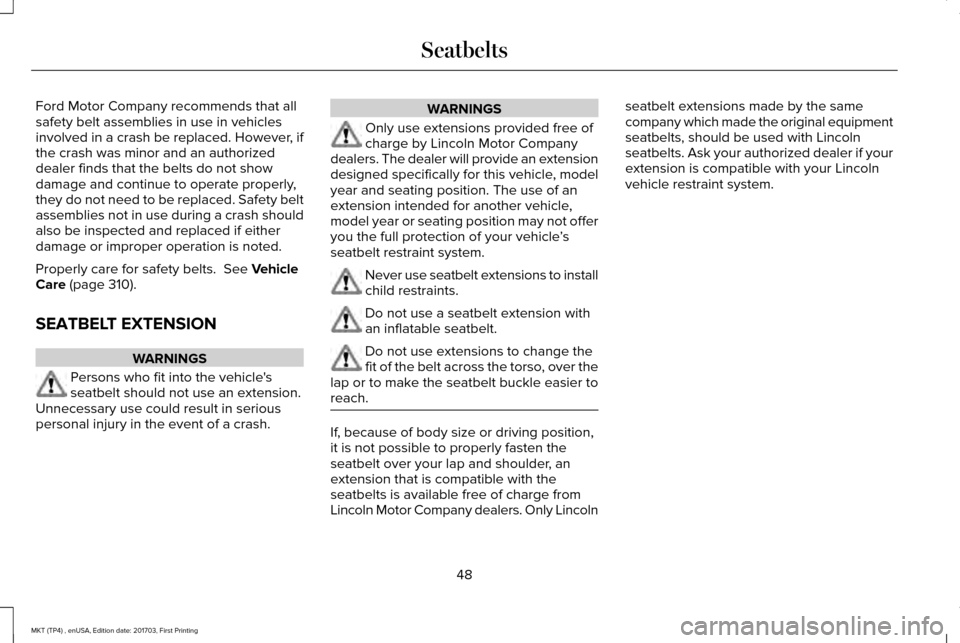
Ford Motor Company recommends that all
safety belt assemblies in use in vehicles
involved in a crash be replaced. However, if
the crash was minor and an authorized
dealer finds that the belts do not show
damage and continue to operate properly,
they do not need to be replaced. Safety belt
assemblies not in use during a crash should
also be inspected and replaced if either
damage or improper operation is noted.
Properly care for safety belts. See Vehicle
Care (page 310).
SEATBELT EXTENSION WARNINGS
Persons who fit into the vehicle's
seatbelt should not use an extension.
Unnecessary use could result in serious
personal injury in the event of a crash. WARNINGS
Only use extensions provided free of
charge by Lincoln Motor Company
dealers. The dealer will provide an extension
designed specifically for this vehicle, model
year and seating position. The use of an
extension intended for another vehicle,
model year or seating position may not offer
you the full protection of your vehicle ’s
seatbelt restraint system. Never use seatbelt extensions to install
child restraints.
Do not use a seatbelt extension with
an inflatable seatbelt.
Do not use extensions to change the
fit of the belt across the torso, over the
lap or to make the seatbelt buckle easier to
reach. If, because of body size or driving position,
it is not possible to properly fasten the
seatbelt over your lap and shoulder, an
extension that is compatible with the
seatbelts is available free of charge from
Lincoln Motor Company dealers. Only Lincolnseatbelt extensions made by the same
company which made the original equipment
seatbelts, should be used with Lincoln
seatbelts. Ask your authorized dealer if your
extension is compatible with your Lincoln
vehicle restraint system.
48
MKT (TP4) , enUSA, Edition date: 201703, First Printing Seatbelts